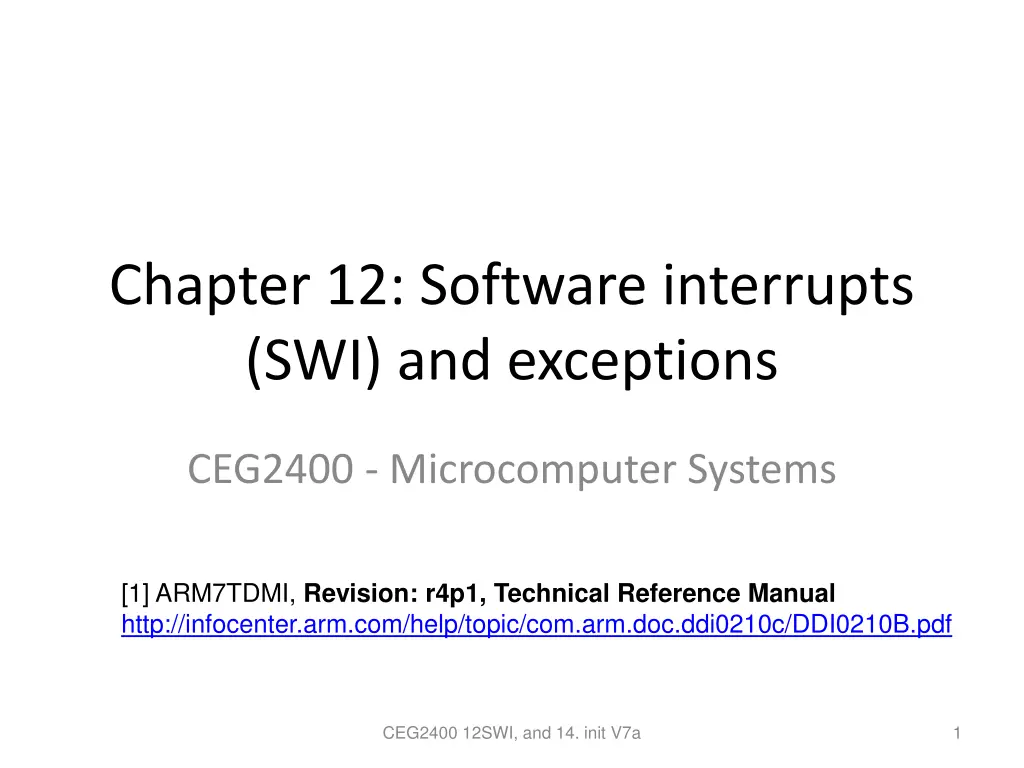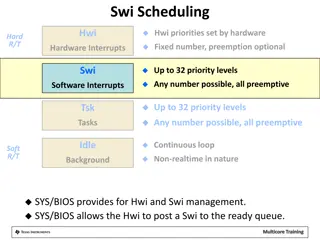
Understanding Software Interrupts and Exceptions in Microcomputer Systems
Explore the concepts of software interrupts and exceptions in microcomputer systems, including their types, triggers, and importance. Learn how interrupts and exceptions affect program execution and processor behavior.
Download Presentation

Please find below an Image/Link to download the presentation.
The content on the website is provided AS IS for your information and personal use only. It may not be sold, licensed, or shared on other websites without obtaining consent from the author. If you encounter any issues during the download, it is possible that the publisher has removed the file from their server.
You are allowed to download the files provided on this website for personal or commercial use, subject to the condition that they are used lawfully. All files are the property of their respective owners.
The content on the website is provided AS IS for your information and personal use only. It may not be sold, licensed, or shared on other websites without obtaining consent from the author.
E N D
Presentation Transcript
Chapter 12: Software interrupts (SWI) and exceptions CEG2400 - Microcomputer Systems [1] ARM7TDMI, Revision: r4p1, Technical Reference Manual http://infocenter.arm.com/help/topic/com.arm.doc.ddi0210c/DDI0210B.pdf CEG2400 12SWI, and 14. init V7a 1
A brief introduction (revision) of interrupt/exception CEG2400 12SWI, and 14. init V7a 2
What is interrupt/exception? Main () { : Doing something (e.g. browsing) : } ring Phone rings Can happen anytime Depends on types of interrupts _isr() //Interrupt service routine { Phone rings some tasks (e.g. answer telephone) }//when finished, //goes back to main CEG2400 12SWI, and 14. init V7a 3
Examples When your computer is running, a key press will trigger an interrupt to input a character to your system The dispatcher in the operating system is implemented by timer interrupt. Timer interrupts the CPU at a rate of 1KHz At each interrupt the system determines which task to run next. CEG2400 12SWI, and 14. init V7a 4
Important interrupts SWI Interrupts Software Interrupt SWI-XX Triggered by the software instruction SWI x Hardware Interrupt FIQ,IRQ Reset (or power up) Triggered by hardware sources Triggered by power_up/ reset_key External Interrupt EINT ADC Timer CEG2400 12SWI, and 14. init V7a 5
Interrupt and exception The terms are used differently by various manufacturers Traditionally exception means The normal operation of a program is interrupted and the processor will execute another piece of software (exception handling) somewhere. Interrupt (hardware interrupt) is an exception caused by some hardware condition happening outside the processor (e.g. external hard interrupt, IRQ FIQ). Software interrupt (SWI) is an exception caused by an assembly software instruction (SWI 0x?? exception call instruction) written in the software code. Trap is an exception caused by a failure condition of the processor (e.g. abort pre-fetch , data , undefined instruction, divided_by_zero, or stack overflow etc) CEG2400 12SWI, and 14. init V7a 6
Important interrupts in words Reset, a special interrupt to start the system happens at power up , or reset button depressed) Software interrupt SWI: similar to subroutine happens when SWI 0x?? is written in the program Hardware interrupt FIQ (fast interrupt) or IRQ (external interrupt), when the external interrupt request pin is pulled low, or an analogue to digital conversion is completed, or A timer/counter has made a regular request Inside LPC2131 Interrupt request generated Counter overflow Timer/Counter IRQ End of conversion Interrupt handling hardware ADC FIQ End of transmission UART CEG2400 12SWI, and 14. init V7a 7
Introduction to Software Interrupt (SWI) CEG2400 12SWI, and 14. init V7a 8
Compare hardware and software interrupt Hardware interrupt, e.g. A falling edge at EINT3 will trigger the execution of the interrupt service routine __irq IRQ_Eint1() IRQ_Eint1() { :: } Computer EINT3 Software interrupt Computer Main{ : SWI N : } An instruction SWI N in the program will trigger the execution of the N-th-sys-routine (system routine) N-th-sys-routine() { :: } CEG2400 12SWI, and 14. init V7a 9
Exception (interrupt) Modes ARM supports 7 types of exceptions and has a privileged processor mode for each type of exception. ARM Exception (interrupt) vectors SWI Address Exception Mode in Entry 1 0x00000000 Reset Supervisor 2 0x00000004 Undefined instruction Undefined 3 0x00000008 Software Interrupt Supervisor 4 0x0000000C Abort (prefetch) Abort 5 0x00000010 Abort (data) Abort x 0x00000014 Reserved Reserved IRQ 6 0x00000018 IRQ (external interrupt) IRQ 7 0x0000001C FIQ (fast interrupt) FIQ CEG2400 12SWI, and 14. init V7a 10
Different types of exceptions 1) Reset (supervisor model, at power up , or reset button depressed) Undefined Instruction (for co-processors *) *Prefetch Abort for instruction fetch memory fault *Data Abort : for data access memory fault Software Interrupt (SWI) : supervisor mode, operating sys. calls FIQ (Fast interrupt request) IRQ (interrupt request) * not discussed here , refer to http://infocenter.arm.com/help/topic/com.arm.doc.ddi0210c/DDI0210B.pdf 2) 3) 4) 5) 6) 7) CEG2400 12SWI, and 14. init V7a 11
Student ID: ___________,Date:_____________ Name: __________________________________ Exercise 12.1 A.What should a CPU do when it enters interrupt? Answer: __________________________________ B.What is the difference between software and hardware interrupt? Answer: __________________________________ C. What is the meaning of Trap? Answer: __________________________________ D. Name all interrupts of LPC2131 and their entry addresses. Answer: __________________________________ CEG2400 12SWI, and 14. init V7a 12
common usage of exceptions For building operating systems Reset (supervisor model, at power up , or reset button depressed) Undefined Instruction (for co-processors *) *Prefetch Abort for instruction fetch memory fault *Data Abort: for data access memory fault Software Interrupt (SWI) : supervisor mode, operating sys. calls For embedded systems, hardware systems FIQ (Fast interrupt request) IRQ (interrupt request) * not discussed here , refer to http://infocenter.arm.com/help/topic/com.arm.doc.ddi0210c/DDI0210B.pdf CEG2400 12SWI, and 14. init V7a 13
ARM Registers 32-bit CEG2400 12SWI, and 14. init V7a 14
Recall program status regs Mode of interrupt 28 4 0 31 8 N Z C V I F T Mode Copies of the ALU status flags (latched if the instruction has the "S" bit set). * Interrupt Disable bits. I = 1, disables the IRQ. F = 1, disables the FIQ. * Condition Code Flags N = Negative result from ALU flag. Z = Zero result from ALU flag. C = ALU operation Carried out V = ALU operation oVerflowed * T Bit (Architecture v4T only) T = 0, Processor in ARM state T = 1, Processor in Thumb state CEG2400 12SWI, and 14. init V7a 15
Recall: registers General registers and Program Counter User32 / System FIQ32 Supervisor32 Abort32 IRQ32 Undefined32 r0 r0 r0 r0 r0 r0 r1 r1 r1 r1 r1 r1 r2 r2 r2 r2 r2 r2 r3 r3 r3 r3 r3 r3 r4 r4 r4 r4 r4 r4 Shaded registers are extra Registers for different modes r5 r5 r5 r5 r5 r5 r6 r6 r6 r6 r6 r6 r7 r7 r7 r7 r7 r7 r8 r8_fiq r8 r8 r8 r8 r9 r9_fiq r9 r9 r9 r9 r10 r10_fiq r10 r10 r10 r10 r11 r11_fiq r11 r11 r11 r11 r12 r12_fiq r12 r12 r12 r12 r13 (sp) r13_fiq r13_svc r13_abt r13_irq r13_undef r14 (lr) r14_fiq r14_svc r14_abt r14_irq r14_undef r15 (pc) r15 (pc) r15 (pc) r15 (pc) r15 (pc) r15 (pc) Program Status Registers cpsr cpsr cpsr cpsr cpsr cpsr sprsr_fiq sprsr_fiq sprsr_fiq sprsr_fiq sprsr_fiq spsr_fiq spsr_svc spsr_abt sprsr_fiq sprsr_fiq sprsr_fiq sprsr_fiq sprsr_fiq spsr_irq sprsr_fiq sprsr_fiq sprsr_fiq sprsr_fiq sprsr_fiq spsr_undef SPSR= Saved Process Status Reg CEG2400 12SWI, and 14. init V7a 16
28 4 0 31 8 N Z C V I F T Mode Mode bits M[0:4] : bit0->bit4 of CPSR http://infocenter.arm.com/help/topic/com.arm.doc.ddi0210c/DDI0210B.pdf CEG2400 12SWI, and 14. init V7a 17
We will study Software Interrupt (SWI) CEG2400 12SWI, and 14. init V7a 18
Why Software interrupt SWI? Similar to a subroutine call but more efficient and organized Make a list of often used routines To build system calls in Linux or Windows. E.g. print character , read keyboard etc.. CEG2400 12SWI, and 14. init V7a 19
SWI software interrupt For operating sys. (OS) developers to write often used routines E.g. SWI 0x12 is for write a character to screen So you may have a table of all routines and called by users or OS programs. SWI table 0x01= reset system 0x02= init timer : 0x12 = write a charter to screen 0x13= make a beep sound for 0.5 seconds CEG2400 12SWI, and 14. init V7a 20
Example E.g.1 For Building OS Operating system calls SWI software interrupt for writing OS calls An efficient way for user to make OS calls Examples, SWI table SWI 20 = Print text on screen SWI 23 =Read real time clock SWI 35 =Keyboard read - Main() { : : : Supervisor mode SWI x ;software interrupt Program for SWI x Print a character to screen } CEG2400 12SWI, and 14. init V7a 21
Code Example When SWI is in your code: E.g. SWI vector=SWI 0x11, vector =0x11 CEG2400 12SWI, and 14. init V7a 22
SWI interrupt procedures (enter the supervisor mode) SWI (software interrupt ) Caused by SWI 0x?? in your program Arm completes the current instruction. Goto SWI exception address 0x08 (short form for 0x000 0008) Exception entry, execution procedure (see next slide) {Change to supervisor op. mode :CPSR (bit0-4) : : Return from interrupt MOVS pc, lr return to main} CEG2400 12SWI, and 14. init V7a 23
Details of entering an interrupt (exception) Preserves the address of the next instruction in the appropriate Link Register (e.g. r14_svc r14 of supervisor mode) Copies the CPSR (Current Program Status Register ) into the appropriate SPSR (Saved Process Status Reg. e.g. SPSR_svc) Forces the CPSR mode bits to a value which depends on the exception (supervisor, interrupt etc) Forces the PC (program counter r15) to fetch the next instruction from the relevant exception vector It may also set the interrupt disable flags to prevent otherwise unmanageable nesting of exceptions. http://infocenter.arm.com/help/topic/com.arm.doc.ddi0210c/DDI0210B.pdf CEG2400 12SWI, and 14. init V7a 24
For your reference: SWI Software interrupt execution flow SWI Software interrupt Warning: What was in R0? User program may have been using this register. Therefore, cannot just use it must first save it first (push stack) Usage of BIC (Bit Clear) E.g. BIC R0, R0, #%1011 ; Clear bit-0, bit-1, bit-3 in R0. On SWI, the processor (1) copies CPSR to SPSR_SVC (2) sets the CPSR mode bits to supervisor mode (3) sets the CPSR IRQ to disable (4) stores the value (PC + 4) into LR_SVC (5) forces PC to 0x08 Vector Table (spring board) starting at 0x00 in memory 0x00 0x04 0x08 0x0c 0x10 0x14 0x18 0x1c SWI Handler:0x40001000 (S_Handler) USER Program:0x40002000 to R_Handler to U_Handler to S_Handler to P_Handler to D_Handler ... to I_Handler to F_Handler (Reset (Undef instr.) (SWI) (Prefetch abort) (Data abort) (Reserved) (IRQ) (FIQ) ADD r0,r0,r1 SWI 0x02 SUB r2,r2,r0 LDR r0,[lr,#-4] BIC r0,r0,#0xff000000 // now the vector is in r0 switch (r0){ case 0x00: service_SWI1(); case 0x01: service_SWI2(); case 0x02: service_SWI3(); } MOVS pc, lr From www.cs.ucr.edu/~amitra/context_switch/extra/04_swi.ppt CEG2400 12SWI, and 14. init V7a 25
Exercise 12.2: SWI handler : Assume the SWI handler is at 0x40001000 i) What is the content of address 0x08? Why? Answer:?__________________________________________ ii) What will the Processor do when it runs SWI 0x02 Fill in steps that the precessor will do when entering SWI SWI handler (from 0x40001000) :push registers onto stack LDR r0,[lr,#-4] BIC r0,r0,#0xff000000 :swtch(r0) .. etc : User main program (from 0x40002000) Address 0x40002000 0x40002004 0x40002008 instruction ADD r0,r0,r1 SWI 0x02 SUB r2,r2,r0 Step1:_________________ Step2 :_________________ Step3 :_________________ Step4 :_________________ Step5:__________________ :pop registers from stack MOVS pc, lr; return from interrupt 26 CEG2400 12SWI, and 14. init V7a
Exercise 12.3 SWI handler Inside the SWI handler i) What are the mode bits M[0:4] : bit0->bit4 of CPSR? Answer: ?______________ Ii) What is the running mode inside the SWI handler: supervisor or user32? ANSWER: ?___________________________________ III) When the link register lr is used, which lr the processor is using :r14(lr) or r14_svc or r14_irq? Answer?__________________________________ The Machine code of SWI 0x02 is 0xea000002 . List the values of r0 after the first and second instruction of the SWI handler. 1. LDR r0,[lr,#-4] ; fill in the blank, r0 = ?_______ 2. BIC r0,r0,#0xff000000; clear most significant 2 bytes of r0; r0=?_____ 3. // now the vector is in r0 4. switch (r0){ 5. case 0x00: service_SWI1(); 6. case 0x01: service_SWI2(); 7. case 0x02: service_SWI3(); 8. 9. } CEG2400 12SWI, and 14. init V7a 27
Details of leaving an interrupt ARM7TDMI tech. ref. (section 2.8 exception)[1] Bye Bye! At the end of the SWI handler: Movs pc,lr Move the r14, minus an offset to the PC. The offset varies according to the type (auto) SPSR_svc CPSR. (auto) Clear the interrupt disable flags that were set on entry CEG2400 12SWI, and 14. init V7a 28
Summary Learned the basic concept of exceptions and interrupts SWI (Software interrupt) CEG2400 12SWI, and 14. init V7a 29
Appendix Alternative set bit method in C Y=0x1<<21;//left shift 21 bits, this sets bit21=1 and other bits= 0 Before shift Y=0x1=0000 0000 0000 0000 0000 0000 0000 0001 (Binary) After shift Y= 0000 0000 0010 0000 0000 0000 0000 0000 (Binary) bit 31 bit 21 bit0 Exercise: set bit 9 of register R to be 1, other bits to be 0. Answer=0x1<<9; So R=0000 0000 0000 0000 0000 0010 0000 0000 (Binary) =0x200 Bit9 =1 CEG2400 12SWI, and 14. init V7a 30










